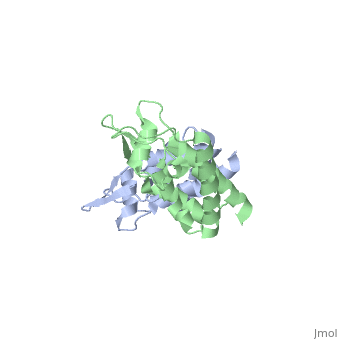Function
The Gag polyprotein (Gag) is part of the basic infrastructure of retroviruses. The Gag is processed during maturation to matrix protein (MA), capsid protein (CA), spacer peptides (SP1, SP2), nucleocapsid protein (NC) and p6. For detailed discussion of HIV-1 Gag polyprotein see Hiv-1 gag.
Gag of human immunodeficiency virus type 1 (HIV-1), is a primary protein involved in the packaging of two copies of the viral genome for capsid formation [1]. In the cytoplasm of the infected cell, Gag is translated and approximately 1500 copies of the immature HIV-1 Gag polyprotein 1l6n come together to form an immature viral particle. After budding of the viral particle, viral proteases cleave the Gag protein into three structurally different products: the matrix, the capsid, and the nucleocapsid. The protealytic cleavage results in viral maturation and induces significant structural changes of the protein products. Following this proteolysis, the viral particle takes on the classic cone shape required for a new infection.
Capsid (CA) Domain
Overall, the mature CAN domain is very similar in structure to the corresponding domain of the immature Gag283 polyprotein. The CAN protein contains 7 α-helices (helix 1-helix 7) that pack together to form a triangular shape, which helps facilitate the final complex formation for the capsid core particles. There are two significant structural differences between the immature and mature versions of the CAN domain: an N-terminal β-hairpin and a 2-Angstrom displacement of helix 6.
In the mature CAN protein, the N-terminal residues form an anti-parallel β-hairpin instead of the random coil that is observed when the same residues are compared in the immature Gag283 polyprotein. The NH2+ group of the N-terminus proline establishes a salt bridge with a nearby aspartic acid, which stabilizes the β-hairpin. This N-terminal β-hairpin is required for the final formation of the viral capsid, and many studies have shown through conservation and mutagenesis that this β-hairpin is responsible for the stabilization of the protein complexes involved in the capsid formation [2][3].
As a side effect of the β-hairpin formation, the helix 6 is displaced by approximately 2-Angstroms. This displacement, though structurally minor, causes significant biological changes in the protein. Most importantly, helix 6 interacts with the protein cyclophilin A (CypA)-binding site. CypA is a prolyl isomerase and chaperone protein involved in the infection process by aiding in unpacking the capsid [4][5][6].
Implications
HIV-1 viral particles need to form a capsid cone-like structure prior to infection of the host cell. The protealytic cleavage of the immature Gag283 polyprotein results in a capsid domain. This post-translational modification is essential to the formation of the core structure. Many studies have shown that the β-hairpin formed after maturation is essential for the capsid core particle formation [2][3]. As a result of the β-hairpin formation, the helix 6 is displaced causing an allosteric mechanism for CpyA binding. Overall, the maturation of Gag283 and formation of the mature CA protein is essential for core capsid particle creation and consequently final infection.
3D structures of Gag polyprotein
Gag polyprotein 3D structures






